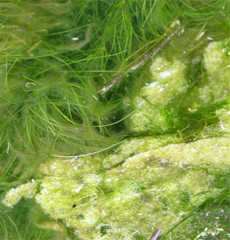
ALGAE AND NUTRIENT REDUCTION

| Liebig's Law of the Minimum can be used to effectively control algal blooms in a eutrified pond or lake. The addition of microbes, in a process called bioremediation, can reduce nutrients to effective control algae. |
| Bioremediation and the Role Of Nutrient Reduction | ||
|
How does nutrient reduction help reduce algal blooms? The ultimate goal is to prevent noxious algal blooms (e.g., dinoflagellates and blue-green cyanobacteria) by nutrient manipulation. The growth of algae can be manipulated by nutrient dynamics. This is can be achieved through bioaugmentation in a process called biological nutrient removal (BNR). Based on the stoichiometric composition of algae, typically, either nitrogen (N) or phosphorous (P) is the element present in the algal environment that, when supplied at a rate less than needed, can limit the growth of algae; this is the limiting element. (Liebig's Law of the Minimums) This is important in managing eutrophication-related water-quality impairment. Oxygen Nitrogen Phosphorous As little as 15 parts per billion of total phosphorous can encourage excessive production algae. Undesirable aquatic plant growth results from additions of phosphorus to the water. The net result of the eutrophic condition and excess plant growth in water is the depletion of oxygen in the water due to the heavy oxygen demand by microorganisms as they decompose the organic material. It severely impacts the lakes natural ability to support aquatic life. ( More information ..... common algae found in ponds and lakes) More information ........ on copper resistant algae Product information on - Eutro-Clear - for nutrient reduction in eutrophied ponds |
|